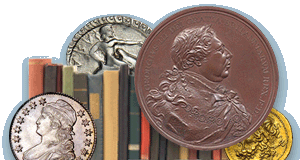
PREV ARTICLE
NEXT ARTICLE
FULL ISSUE
PREV FULL ISSUE
MORE ON NUMISMATIC BOOK DUST JACKETS
Regarding my reply to Christopher Buck's question about how to "determine if a coin book (or ANY book for that matter) was
originally published with a dust jacket", George Kolbe submitted this thoughtful response. -Editor
Your conjecture is manifestly correct of course. There is no way to determine if a book was issued in a dust jacket beyond documenting that such is the case. And there are “wrinkles.” Originally, a dust wrapper or dust jacket was intended to protect a new book from its adjective until the volume in question was sold. Having served its purpose it was then often discarded. Many earlier dust jackets feature no printing. Among numismatic works fitting that criterion are Horatio Robinson Storer’s 1931 Medicina in Nummis and Richard Bowen’s 1942 Rhode Island Colonial Money and Its Counterfeiting, to name but a few American publications. Even a numismatic bookseller employed the practice, witness the 1984 catalogue of the Lester Merkin library. Modern dust jackets have little to do with solid particulate matter and everything to do about marketing. Plain dust jackets stifle sales. Imagine a bookstore display of the 1931 and 1942 works [1] mentioned above: an unending blob of brown kraft paper. Blah! Contrast that with an image of Tarzan, vanquishing a lion and saving a beautiful maiden, in full color. I doubt any of those are still lying around, mint in their original pictorial jackets. In numismatic circles, the presence or absence of a dust jacket generally has but a modest impact on value. The opposite is often true in the general world of books, particularly modern fiction. There, an original dust jacket is typically worth more than the volume it encompasses. Many modern novels feature dust jackets designed by talented and famous artists of the day and their presence and, particularly, their state of preservation, is key. Suffice it to say that not only are coins counterfeited. Replicas of older pictorial dust jackets have become a plague in the book world. Luckily, their detection at present is easier for those with a discerning eye, due to the unavailability of the raw materials involved (paper and ink), combined with the obsolete technologies involved. [1] Neither were commercially published and their paper covers likely stifled sales; decades after publication your scribe purchased multiple brand new copies of both, with dust jackets intact.
Thanks, George. I wasn't aware of the fake dust jacket problem.
I believe the increasing level of digitization of numismatic literature will greatly increase attention to physical details of the books we collect, from overall condition to the presence of original dust jackets. Over time this could lead to higher prices for the rare surviving intact dust jackets. For many years I upgraded my books whenever given the opportunity, and I placed Brodart protectors over many of my dust jackets. I have at least a few numismatic dust jackets in near perfect condition. I've always been proud of this minor accomplishment, even though few others cared. Time will tell if the effort was worth it financially, but at least I can feel good about saving a few of them from the landfill. -Editor To read the complete article, see:

Wayne Homren, Editor The Numismatic Bibliomania Society is a non-profit organization promoting numismatic literature. See our web site at coinbooks.org. To submit items for publication in The E-Sylum, write to the Editor at this address: whomren@gmail.com To subscribe go to: https://my.binhost.com/lists/listinfo/esylum All Rights Reserved. NBS Home Page Contact the NBS webmaster 
|